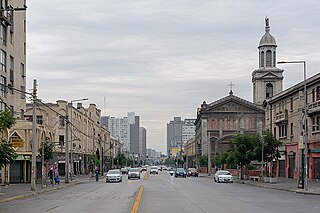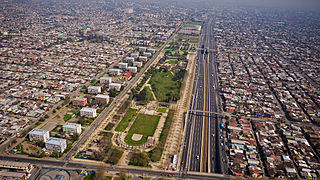
La Reina is a commune of Chile located in Santiago Province, Santiago Metropolitan Region, created in 1963 from an eastern portion of the Ñuñoa commune. It belongs to the Northeastern zone of Santiago de Chile.

Maipú is a commune of Chile located in Santiago Province, Santiago Metropolitan Region, integrated into the Greater Santiago conurbation. It was founded on 16 February 1821 and it is the place of the Battle of Maipú, where Chile's independence was consolidated. Inhabitants are mostly part of a middle class.

Cerro Navia is a commune of Chile located in Santiago Province, Santiago Metropolitan Region. It is one of the most densely populated communes of Santiago, Chile.

Conchalí is a commune of Chile located in Santiago Province, Santiago Metropolitan Region. It is a northwestern suburb of Santiago.
El Bosque is a commune of Chile located in Santiago Province, Santiago Metropolitan Region. The commune spans an area of 14.1 km2 (5 sq mi).

Independencia is a commune of Chile located in Santiago Province, Santiago Metropolitan Region. The main street is Independencia Avenue.

La Cisterna is a commune of Chile and census-designated city located in Santiago Province, Santiago Metropolitan Region. It was founded on 30 May 1925. It is part of Greater Santiago.

San Ramón is a commune of Chile located in Santiago Province, Santiago Metropolitan Region; part of Greater Santiago.
La Granja is a commune of Chile located in Santiago Province, Santiago Metropolitan Region.

Lo Prado is a Chilean commune located in Santiago, which is itself part of the Metropolitan region of Chile. It is part of the Greater Santiago urban area.

Macul is a commune of Chile located in the central-eastern part of the Greater Santiago area, bordered by the communes of Ñuñoa to the north, San Joaquín to the west, Peñalolén to the east and La Florida to the south.

Peñalolén is a Chilean commune in Santiago Province, Santiago Metropolitan Region. It was founded on 15 November 1984.
San Joaquín is a commune of Chile located in Santiago Province, Santiago Metropolitan Region. It is part of Greater Santiago.
San Miguel is a commune of Chile located in Santiago Province, Santiago Metropolitan Region. It was founded on August 10, 1896.

San Bernardo is a city of Chile, part of the Greater Santiago conurbation. Administratively, it is a commune and the capital of the Maipo Province in the Santiago Metropolitan Region. It is the seat of the Roman Catholic Diocese of San Bernardo.

Pirque is a commune of Chile in Cordillera Province, Santiago Metropolitan Region; it is located 2.8 kilometers southeast of Puente Alto and 21.3 kilometers south-southeast of the center of Santiago. It is situated at the base of the Cajón del Maipo, and is the home of the Concha y Toro wine company.
Padre Hurtado is a Chilean commune in the Talagante Province, in the Metropolitan Region. Part of the Greater Santiago conurbation and one of the outermost communes of it, the commune is named after Saint Alberto Hurtado, who was popularly known as Padre Hurtado.

Estación Central is a commune of Chile located in Santiago Province, Santiago Metropolitan Region. Its namesake is the Estación Central railway station located in the commune.

Talagante is a commune and the capital city of the province of the same name in the Santiago Metropolitan Region of central Chile. The word Talagante in Quechua comes from talacanta, meaning "Lazo de Hechicero", which was the proper name of the curaca, or ruler, who dominated this central valley on behalf of the Inca empire during the arrival of the Spaniards.

Zapallar is a commune and a town located in Chile's Petorca Province, a part of the Valparaíso Region. It covers 288 km2 of land. Zapallar is located on the coast of the Pacific Ocean approximately 125 km miles northwest of Santiago.




















